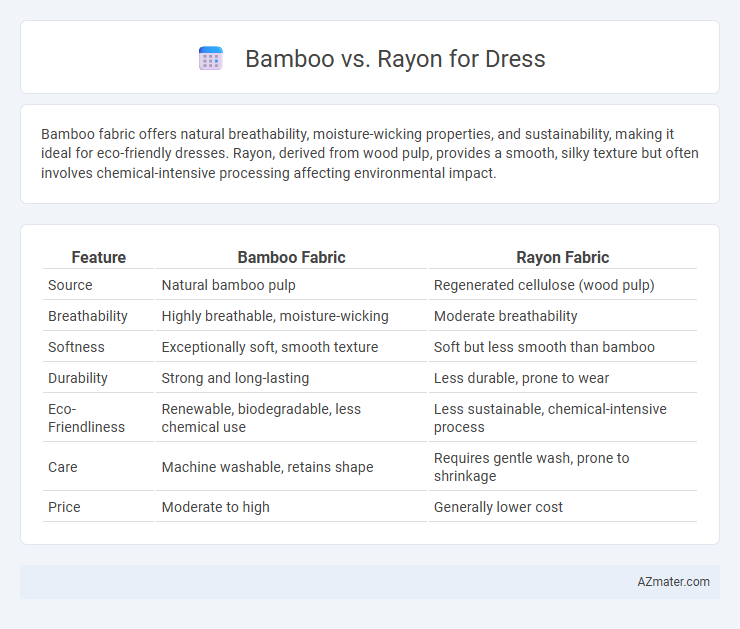Bamboo fabric offers natural breathability, moisture-wicking properties, and sustainability, making it ideal for eco-friendly dresses. Rayon, derived from wood pulp, provides a smooth, silky texture but often involves chemical-intensive processing affecting environmental impact.
Table of Comparison
| Feature | Bamboo Fabric | Rayon Fabric |
|---|---|---|
| Source | Natural bamboo pulp | Regenerated cellulose (wood pulp) |
| Breathability | Highly breathable, moisture-wicking | Moderate breathability |
| Softness | Exceptionally soft, smooth texture | Soft but less smooth than bamboo |
| Durability | Strong and long-lasting | Less durable, prone to wear |
| Eco-Friendliness | Renewable, biodegradable, less chemical use | Less sustainable, chemical-intensive process |
| Care | Machine washable, retains shape | Requires gentle wash, prone to shrinkage |
| Price | Moderate to high | Generally lower cost |
Understanding Bamboo and Rayon Fabrics
Bamboo fabric is derived from natural bamboo fibers through a mechanical or chemical process, offering breathability, moisture-wicking properties, and eco-friendliness due to bamboo's rapid growth and sustainability. Rayon, a semi-synthetic fiber made from regenerated cellulose, often comes from wood pulp or bamboo, providing a smooth, silky texture with excellent drape but typically requiring more chemical processing. Understanding the differences in production, environmental impact, and fabric characteristics helps in choosing between bamboo and rayon for dress materials based on comfort, durability, and sustainability preferences.
Origin and Production Processes
Bamboo fabric is derived from the pulp of bamboo grass, undergoing processes such as mechanical crushing or chemical treatment to extract fibers, which are then spun into yarns. Rayon, often produced from wood cellulose including bamboo, relies on a chemical-intensive process called the viscose method, involving toxic solvents that raise environmental concerns. The distinction lies in bamboo fabric's potential for mechanical production, which is more eco-friendly, whereas rayon typically involves synthetic chemicals regardless of its raw material origin.
Environmental Impact Comparison
Bamboo fabric is often praised for its rapid growth and low need for pesticides, making it an eco-friendly option compared to traditional cotton, but its environmental benefits depend heavily on processing methods. Rayon, including bamboo rayon, involves chemical-intensive production processes that can result in significant water pollution and deforestation if not managed sustainably. Choosing organic or mechanically processed bamboo materials reduces ecological footprints, whereas conventional rayon production typically contributes to higher carbon emissions and habitat degradation.
Softness and Comfort Differences
Bamboo fabric offers superior softness and natural breathability compared to rayon, providing a silky texture that feels gentle against the skin, making it ideal for sensitive wearers. Rayon, while also soft, is manufactured through chemical processing which can affect its moisture-wicking ability and overall comfort. The inherent antimicrobial and hypoallergenic properties in bamboo enhance comfort, whereas rayon may require additional treatments to achieve similar effects.
Durability and Longevity
Bamboo fabric offers superior durability due to its natural antibacterial properties and strong fibers, making it resistant to wear and tear over time. Rayon, while soft and breathable, tends to weaken with frequent washing and exposure to moisture, reducing its overall lifespan. Choosing bamboo for dresses ensures longer-lasting fabric strength and sustained appearance even with regular use.
Breathability and Moisture-Wicking
Bamboo fabric offers superior breathability due to its porous structure, allowing air to flow freely and keep the skin cool and dry. Rayon, although soft and smooth, tends to trap heat and moisture, reducing its effectiveness in moisture-wicking compared to bamboo. Bamboo's natural antimicrobial properties further enhance comfort by preventing odor while maintaining high moisture absorption and quick drying capabilities.
Skin Sensitivity and Hypoallergenic Properties
Bamboo fabric is highly regarded for its natural hypoallergenic properties, making it an excellent choice for sensitive skin due to its smooth texture and ability to resist dust mites and bacteria. Rayon, often derived from bamboo or other cellulose sources, shares similar softness but may involve chemical processing that can affect skin compatibility. Choosing bamboo directly often results in better breathability and moisture-wicking, reducing irritation and promoting comfort for individuals with skin sensitivities.
Maintenance and Care Instructions
Bamboo fabric requires gentle washing in cold water and air drying to maintain its softness and prevent shrinkage, while rayon demands even more delicate care to avoid damage, often needing hand washing or dry cleaning. Both materials are prone to wrinkles, so using a low heat iron with a pressing cloth is recommended to preserve fiber integrity. Proper maintenance ensures longevity, with bamboo offering more durability during regular care compared to the fragile nature of rayon.
Cost and Availability Analysis
Bamboo fabric tends to be more expensive than rayon due to environmentally friendly processing methods and lower production scale, impacting dress cost. Rayon, derived from cellulose, offers widespread availability with numerous manufacturers worldwide, making it a cost-effective option for mass-produced dresses. The choice between bamboo and rayon fabric for dresses depends largely on budget constraints and the desired balance between sustainability and affordability.
Best Uses: Which Fabric for Dresses?
Bamboo fabric offers natural breathability and moisture-wicking properties, making it ideal for casual and summer dresses that require comfort and softness. Rayon, derived from cellulose fibers, provides a smooth, silky texture with excellent drape, perfect for elegant or formal dresses. Choosing between bamboo and rayon depends on dress style and desired functionality: bamboo suits everyday wear and eco-conscious consumers, while rayon excels in luxurious, flowy designs.

Infographic: Bamboo vs Rayon for Dress
 azmater.com
azmater.com